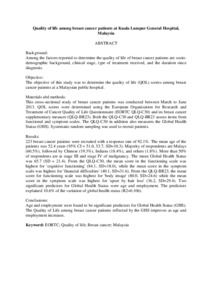Citation
Ganesh, Sri and Lye, Munn Sann and Lau, Fen Nee
(2015)
Quality of life among breast cancer patients at Kuala Lumpur General Hospital, Malaysia.
Asian Pacific Journal of Cancer Prevention, 17 (4).
pp. 1677-1684.
ISSN 1513-7368; ESSN: 2476-762X
Abstract
Background:
Among the factors reported to determine the quality of life of breast cancer patients are socio- demographic background, clinical stage, type of treatment received, and the duration since diagnosis.
Objective:
The objective of this study was to determine the quality of life (QOL) scores among breast cancer patients at a Malaysian public hospital.
Materials abd methods:
This cross-sectional study of breast cancer patients was conducted between March to June 2013. QOL scores were determined using the European Organization for Research and Treatment of Cancer Quality of Life Questionnaire (EORTC QLQ-C30) and its breast cancer supplementary measure (QLQ-BR23). Both the QLQ-C30 and QLQ-BR23 assess items from functional and symptom scales. The QLQ-C30 in addition also measures the Global Health Status (GHS). Systematic random sampling was used to recruit patients.
Results:
223 breast cancer patients were recruited with a response rate of 92.1%. The mean age of the patients was 52.4 years (95% CI = 51.0, 53.7, SD=10.3). Majority of respondents are Malays (60.5%), followed by Chinese (19.3%), Indians (18.4%), and others (1.8%). More than 50% of respondents are at stage III and stage IV of malignancy. The mean Global Health Status was 65.7 (SD = 21.4). From the QLQ-C30, the mean score in the functioning scale was highest for 'cognitive functioning' (84.1, SD=18.0), while the mean score in the symptom scale was highest for 'financial difficulties' (40.1, SD=31.6). From the QLQ-BR23, the mean score for functioning scale was highest for 'body image' (80.0, SD=24.6) while the mean score in the symptom scale was highest for 'upset by hair loss' (36.2, SD=29.4). Two significant predictors for Global Health Status were age and employment. The predictors explained 10.6% of the variation of global health status (R2=0.106).
Conclusions:
Age and employment were found to be significant predictors for Global Health Status (GHS). The Quality of Life among breast cancer patients reflected by the GHS improves as age and employment increases.
Download File
![[img]](http://psasir.upm.edu.my/46061/1.hassmallThumbnailVersion/Quality%20of%20life%20among%20breast%20cancer%20patients%20at%20Kuala%20Lumpur%20General%20Hospital%2C%20Malaysia.pdf)  Preview |
|
Text (Abstract)
Quality of life among breast cancer patients at Kuala Lumpur General Hospital, Malaysia.pdf
Download (7kB)
| Preview
|
|
Additional Metadata
Actions (login required)
 |
View Item |

